Article Review: Fairness in Multicultural Assessment Systems
VerifiedAdded on 2022/11/26
|12
|2706
|304
Report
AI Summary
This report provides a comprehensive review of Gordon Stobart's article, "Fairness in multicultural assessment systems." The review begins with an executive summary and table of contents, followed by a detailed summarization of Stobart's core arguments. The article emphasizes the importance of equity in educational assessments, particularly within multicultural contexts. The report then critically analyzes Stobart's claims, discussing the sociocultural nature of fairness and the interconnectedness of assessment, curriculum, and educational opportunities. The review explores the four key concerns in large-scale assessment: the assessment system's nature, recognition of different groups, cultural diversity, and monitoring group performance. The report concludes by synthesizing the key arguments and offering a critical perspective on the complexities of achieving fair assessment practices, emphasizing the need for transparency in design, constructs, and scoring to address biases and values. The report follows APA format and includes references to relevant literature, providing a well-structured analysis of the article's key themes and implications.
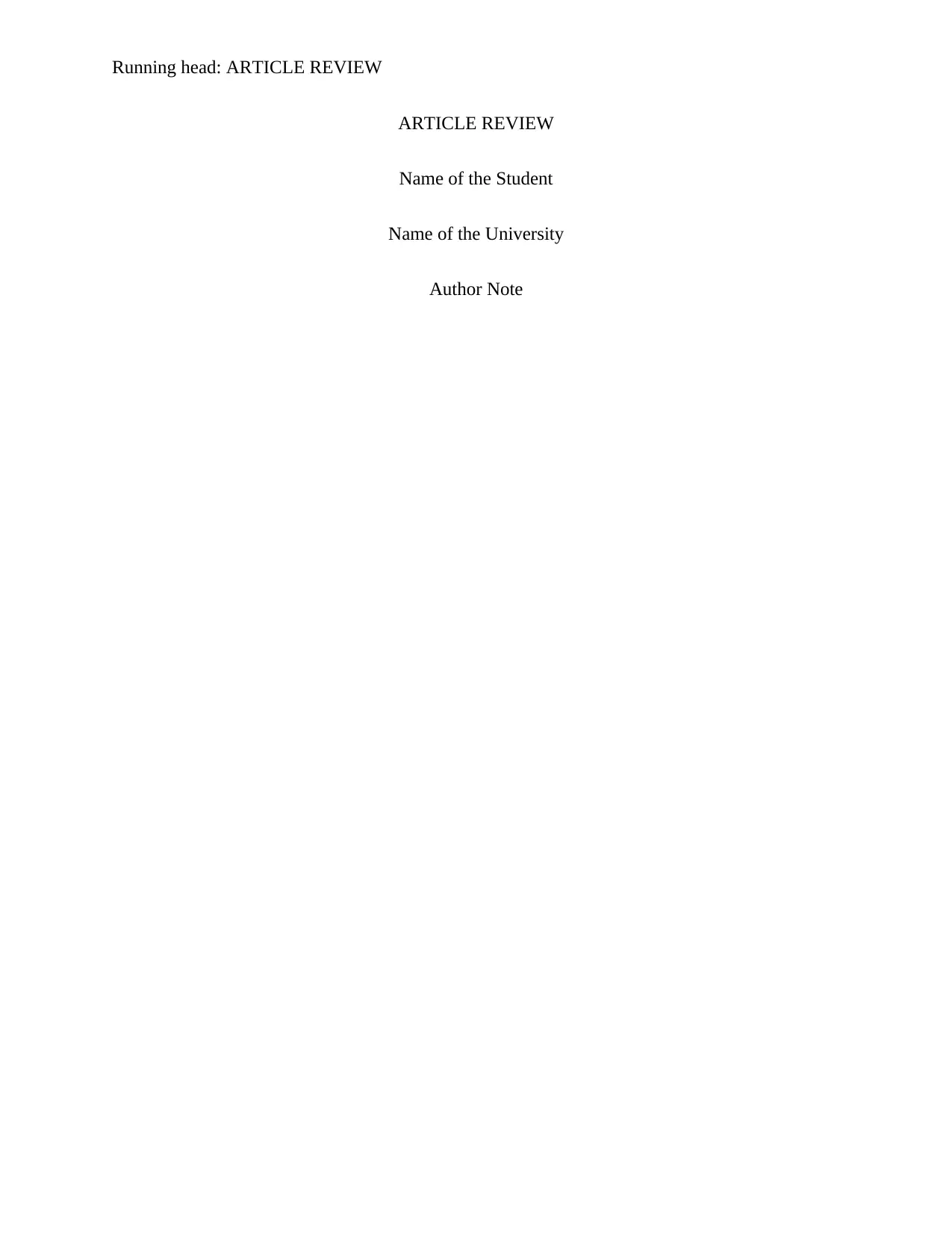
Running head: ARTICLE REVIEW
ARTICLE REVIEW
Name of the Student
Name of the University
Author Note
ARTICLE REVIEW
Name of the Student
Name of the University
Author Note
Paraphrase This Document
Need a fresh take? Get an instant paraphrase of this document with our AI Paraphraser
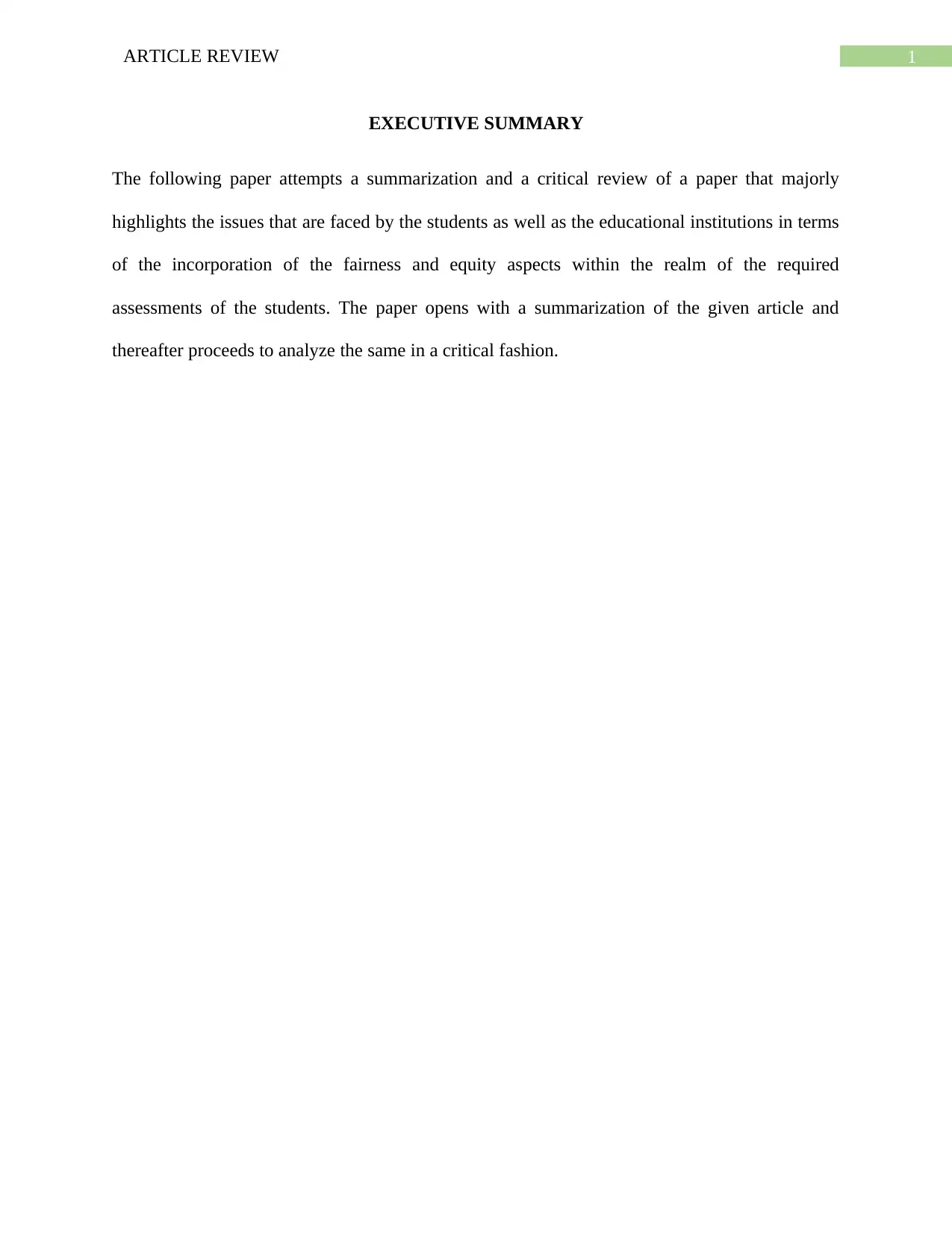
1ARTICLE REVIEW
EXECUTIVE SUMMARY
The following paper attempts a summarization and a critical review of a paper that majorly
highlights the issues that are faced by the students as well as the educational institutions in terms
of the incorporation of the fairness and equity aspects within the realm of the required
assessments of the students. The paper opens with a summarization of the given article and
thereafter proceeds to analyze the same in a critical fashion.
EXECUTIVE SUMMARY
The following paper attempts a summarization and a critical review of a paper that majorly
highlights the issues that are faced by the students as well as the educational institutions in terms
of the incorporation of the fairness and equity aspects within the realm of the required
assessments of the students. The paper opens with a summarization of the given article and
thereafter proceeds to analyze the same in a critical fashion.
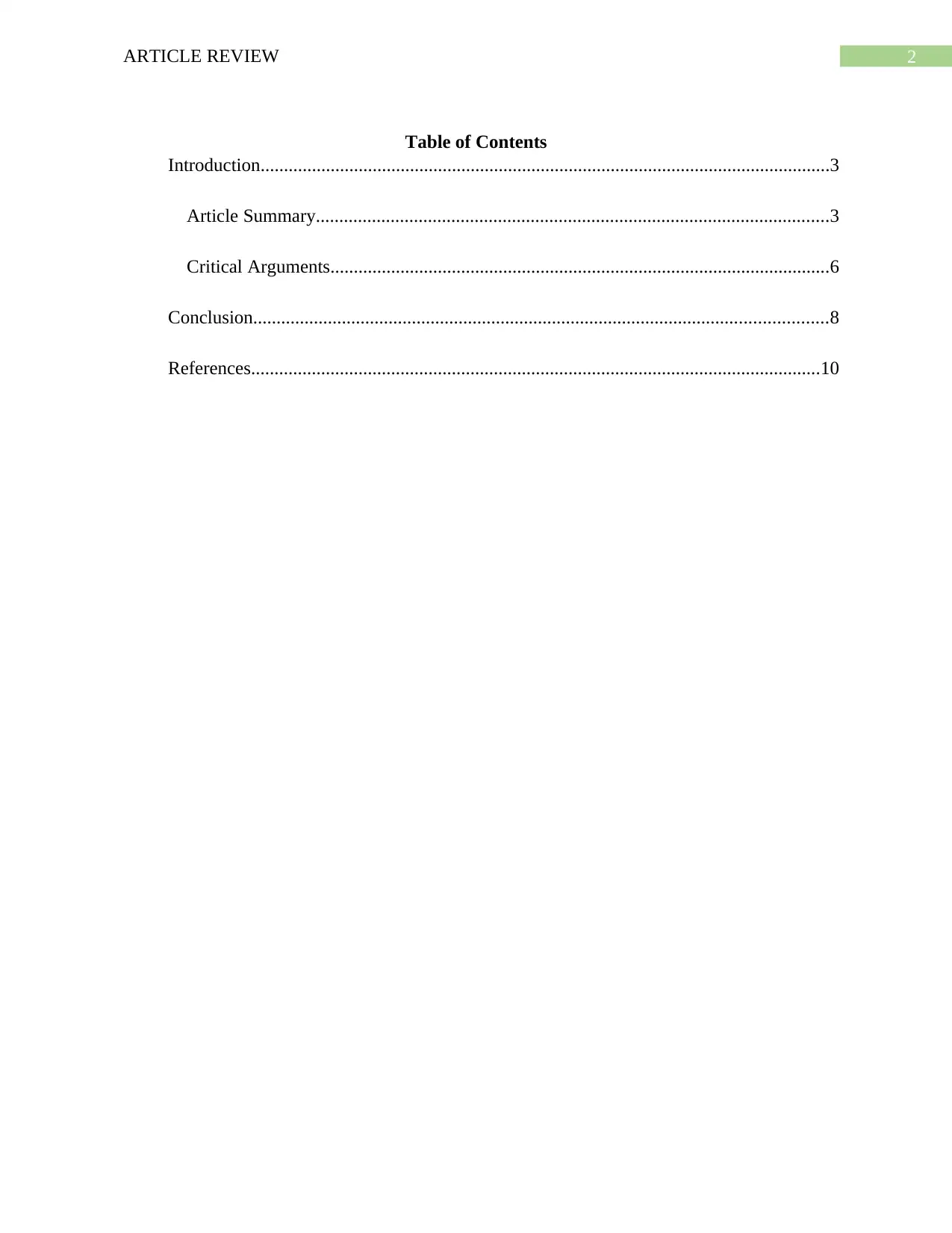
2ARTICLE REVIEW
Table of Contents
Introduction..........................................................................................................................3
Article Summary..............................................................................................................3
Critical Arguments...........................................................................................................6
Conclusion...........................................................................................................................8
References..........................................................................................................................10
Table of Contents
Introduction..........................................................................................................................3
Article Summary..............................................................................................................3
Critical Arguments...........................................................................................................6
Conclusion...........................................................................................................................8
References..........................................................................................................................10
⊘ This is a preview!⊘
Do you want full access?
Subscribe today to unlock all pages.

Trusted by 1+ million students worldwide
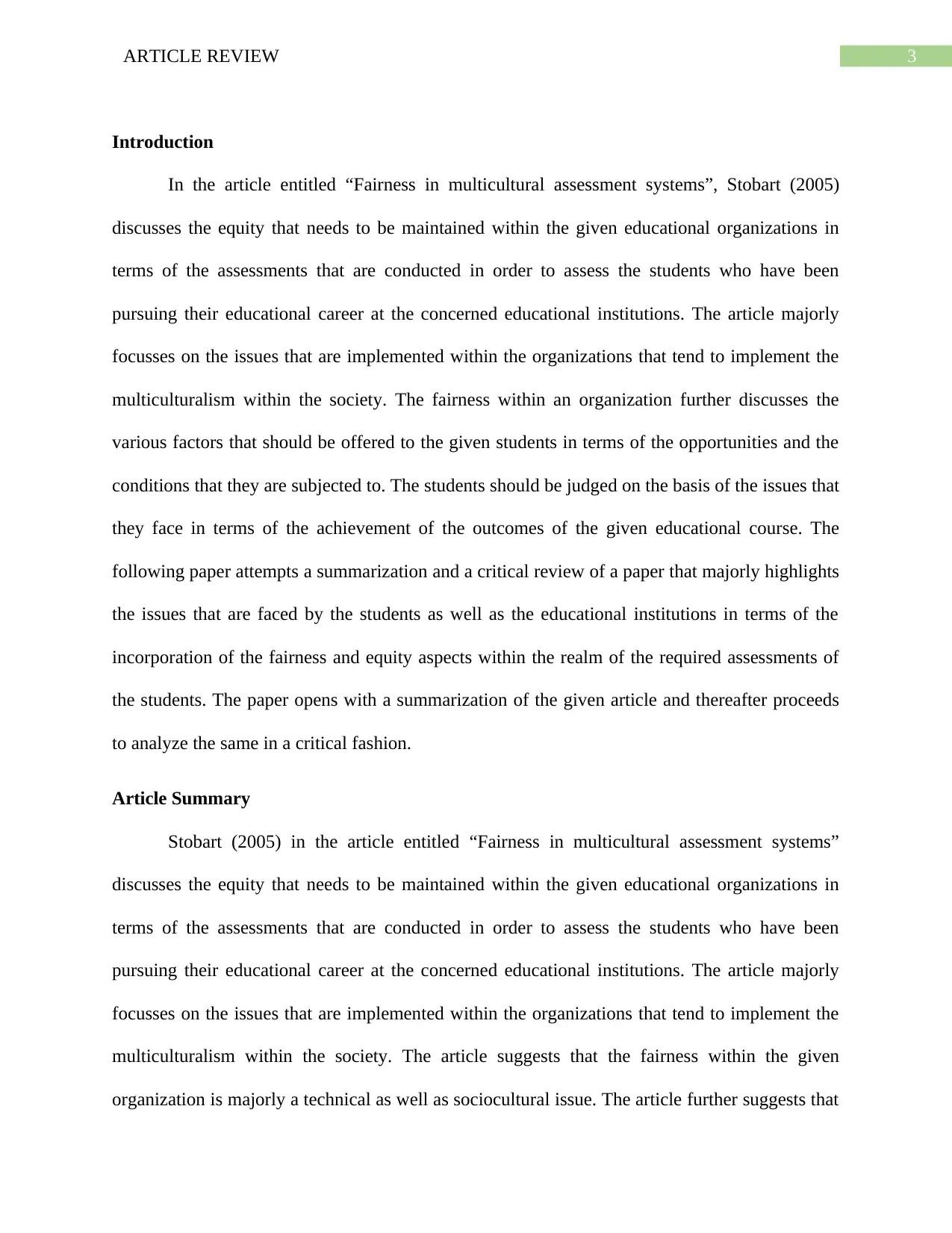
3ARTICLE REVIEW
Introduction
In the article entitled “Fairness in multicultural assessment systems”, Stobart (2005)
discusses the equity that needs to be maintained within the given educational organizations in
terms of the assessments that are conducted in order to assess the students who have been
pursuing their educational career at the concerned educational institutions. The article majorly
focusses on the issues that are implemented within the organizations that tend to implement the
multiculturalism within the society. The fairness within an organization further discusses the
various factors that should be offered to the given students in terms of the opportunities and the
conditions that they are subjected to. The students should be judged on the basis of the issues that
they face in terms of the achievement of the outcomes of the given educational course. The
following paper attempts a summarization and a critical review of a paper that majorly highlights
the issues that are faced by the students as well as the educational institutions in terms of the
incorporation of the fairness and equity aspects within the realm of the required assessments of
the students. The paper opens with a summarization of the given article and thereafter proceeds
to analyze the same in a critical fashion.
Article Summary
Stobart (2005) in the article entitled “Fairness in multicultural assessment systems”
discusses the equity that needs to be maintained within the given educational organizations in
terms of the assessments that are conducted in order to assess the students who have been
pursuing their educational career at the concerned educational institutions. The article majorly
focusses on the issues that are implemented within the organizations that tend to implement the
multiculturalism within the society. The article suggests that the fairness within the given
organization is majorly a technical as well as sociocultural issue. The article further suggests that
Introduction
In the article entitled “Fairness in multicultural assessment systems”, Stobart (2005)
discusses the equity that needs to be maintained within the given educational organizations in
terms of the assessments that are conducted in order to assess the students who have been
pursuing their educational career at the concerned educational institutions. The article majorly
focusses on the issues that are implemented within the organizations that tend to implement the
multiculturalism within the society. The fairness within an organization further discusses the
various factors that should be offered to the given students in terms of the opportunities and the
conditions that they are subjected to. The students should be judged on the basis of the issues that
they face in terms of the achievement of the outcomes of the given educational course. The
following paper attempts a summarization and a critical review of a paper that majorly highlights
the issues that are faced by the students as well as the educational institutions in terms of the
incorporation of the fairness and equity aspects within the realm of the required assessments of
the students. The paper opens with a summarization of the given article and thereafter proceeds
to analyze the same in a critical fashion.
Article Summary
Stobart (2005) in the article entitled “Fairness in multicultural assessment systems”
discusses the equity that needs to be maintained within the given educational organizations in
terms of the assessments that are conducted in order to assess the students who have been
pursuing their educational career at the concerned educational institutions. The article majorly
focusses on the issues that are implemented within the organizations that tend to implement the
multiculturalism within the society. The article suggests that the fairness within the given
organization is majorly a technical as well as sociocultural issue. The article further suggests that
Paraphrase This Document
Need a fresh take? Get an instant paraphrase of this document with our AI Paraphraser
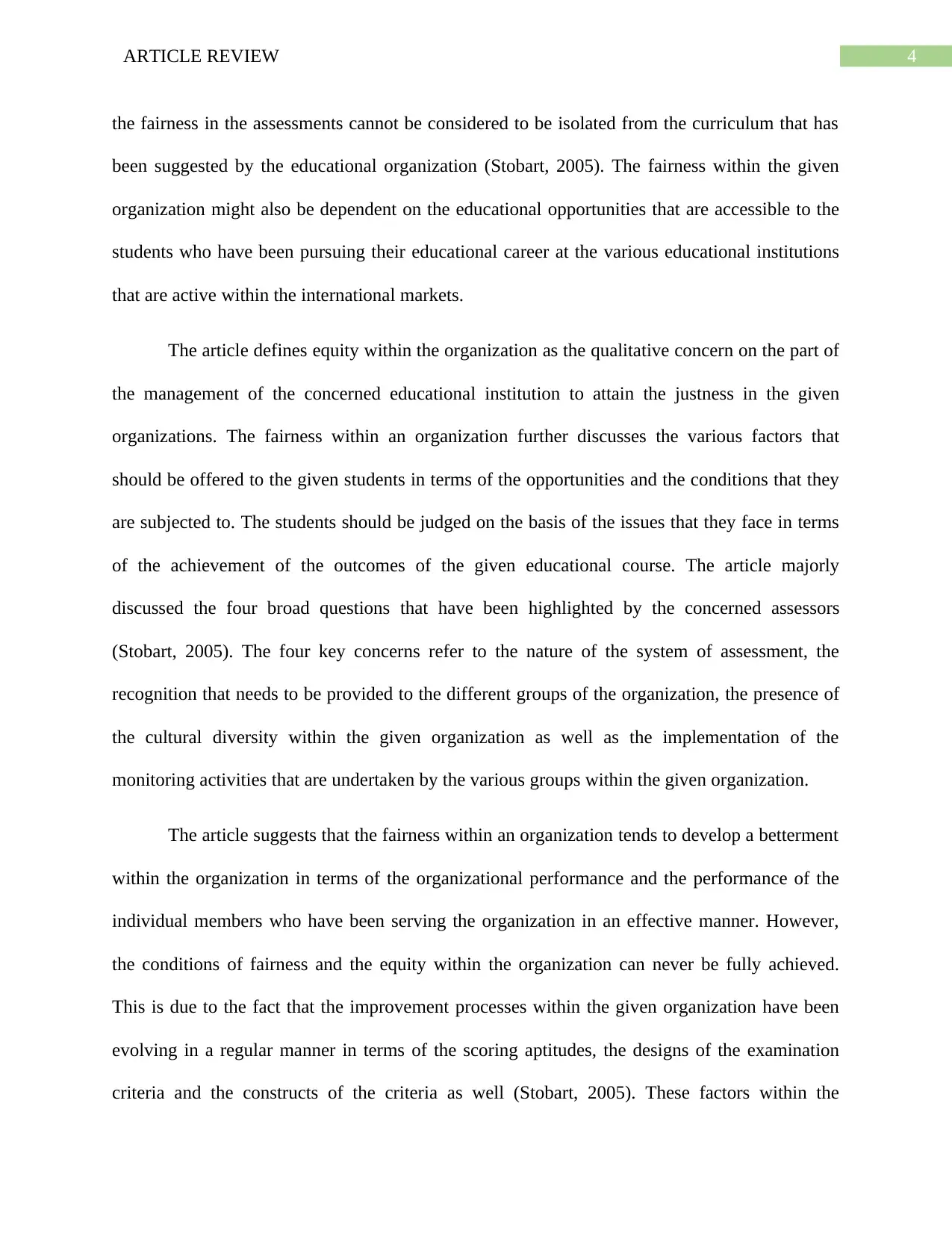
4ARTICLE REVIEW
the fairness in the assessments cannot be considered to be isolated from the curriculum that has
been suggested by the educational organization (Stobart, 2005). The fairness within the given
organization might also be dependent on the educational opportunities that are accessible to the
students who have been pursuing their educational career at the various educational institutions
that are active within the international markets.
The article defines equity within the organization as the qualitative concern on the part of
the management of the concerned educational institution to attain the justness in the given
organizations. The fairness within an organization further discusses the various factors that
should be offered to the given students in terms of the opportunities and the conditions that they
are subjected to. The students should be judged on the basis of the issues that they face in terms
of the achievement of the outcomes of the given educational course. The article majorly
discussed the four broad questions that have been highlighted by the concerned assessors
(Stobart, 2005). The four key concerns refer to the nature of the system of assessment, the
recognition that needs to be provided to the different groups of the organization, the presence of
the cultural diversity within the given organization as well as the implementation of the
monitoring activities that are undertaken by the various groups within the given organization.
The article suggests that the fairness within an organization tends to develop a betterment
within the organization in terms of the organizational performance and the performance of the
individual members who have been serving the organization in an effective manner. However,
the conditions of fairness and the equity within the organization can never be fully achieved.
This is due to the fact that the improvement processes within the given organization have been
evolving in a regular manner in terms of the scoring aptitudes, the designs of the examination
criteria and the constructs of the criteria as well (Stobart, 2005). These factors within the
the fairness in the assessments cannot be considered to be isolated from the curriculum that has
been suggested by the educational organization (Stobart, 2005). The fairness within the given
organization might also be dependent on the educational opportunities that are accessible to the
students who have been pursuing their educational career at the various educational institutions
that are active within the international markets.
The article defines equity within the organization as the qualitative concern on the part of
the management of the concerned educational institution to attain the justness in the given
organizations. The fairness within an organization further discusses the various factors that
should be offered to the given students in terms of the opportunities and the conditions that they
are subjected to. The students should be judged on the basis of the issues that they face in terms
of the achievement of the outcomes of the given educational course. The article majorly
discussed the four broad questions that have been highlighted by the concerned assessors
(Stobart, 2005). The four key concerns refer to the nature of the system of assessment, the
recognition that needs to be provided to the different groups of the organization, the presence of
the cultural diversity within the given organization as well as the implementation of the
monitoring activities that are undertaken by the various groups within the given organization.
The article suggests that the fairness within an organization tends to develop a betterment
within the organization in terms of the organizational performance and the performance of the
individual members who have been serving the organization in an effective manner. However,
the conditions of fairness and the equity within the organization can never be fully achieved.
This is due to the fact that the improvement processes within the given organization have been
evolving in a regular manner in terms of the scoring aptitudes, the designs of the examination
criteria and the constructs of the criteria as well (Stobart, 2005). These factors within the
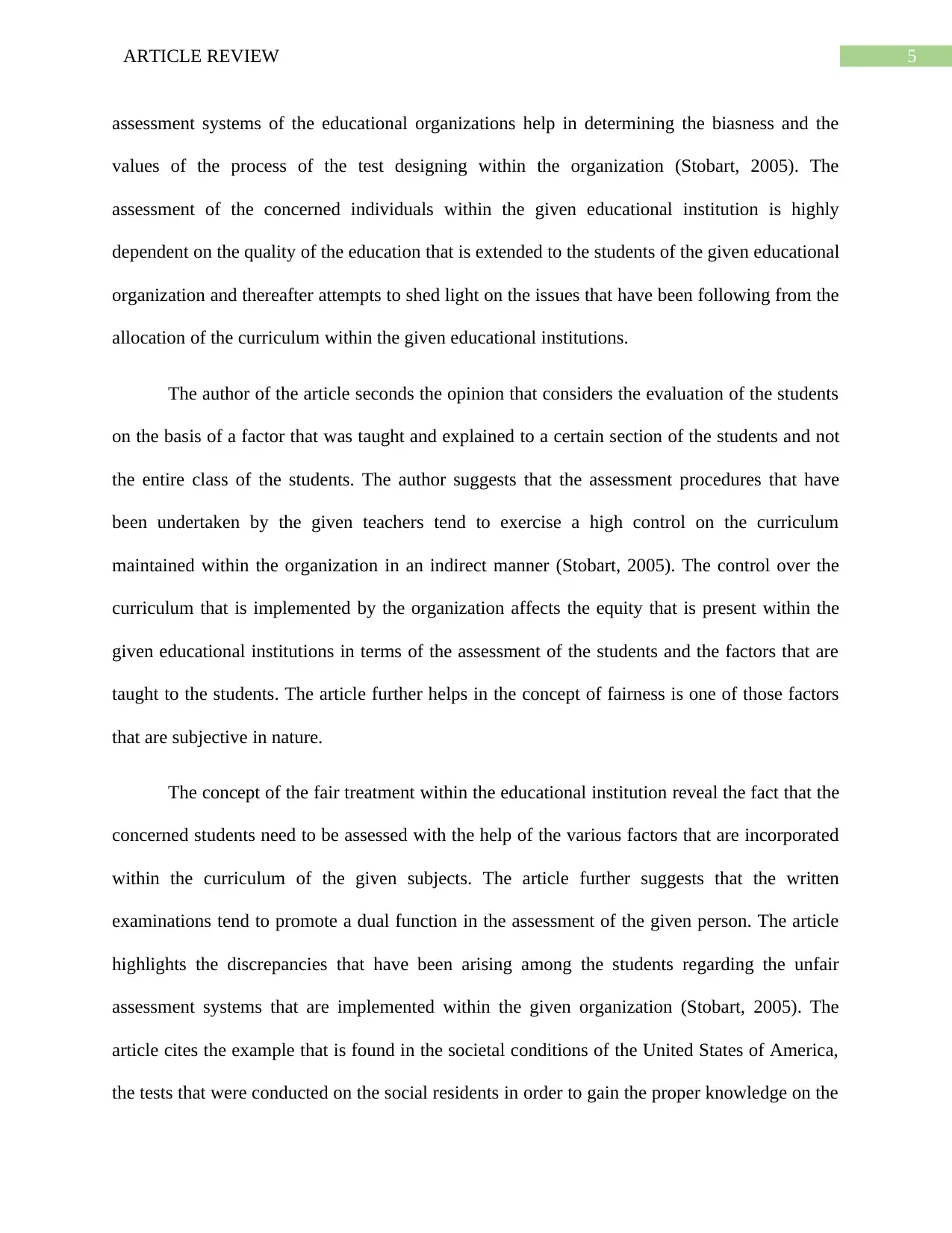
5ARTICLE REVIEW
assessment systems of the educational organizations help in determining the biasness and the
values of the process of the test designing within the organization (Stobart, 2005). The
assessment of the concerned individuals within the given educational institution is highly
dependent on the quality of the education that is extended to the students of the given educational
organization and thereafter attempts to shed light on the issues that have been following from the
allocation of the curriculum within the given educational institutions.
The author of the article seconds the opinion that considers the evaluation of the students
on the basis of a factor that was taught and explained to a certain section of the students and not
the entire class of the students. The author suggests that the assessment procedures that have
been undertaken by the given teachers tend to exercise a high control on the curriculum
maintained within the organization in an indirect manner (Stobart, 2005). The control over the
curriculum that is implemented by the organization affects the equity that is present within the
given educational institutions in terms of the assessment of the students and the factors that are
taught to the students. The article further helps in the concept of fairness is one of those factors
that are subjective in nature.
The concept of the fair treatment within the educational institution reveal the fact that the
concerned students need to be assessed with the help of the various factors that are incorporated
within the curriculum of the given subjects. The article further suggests that the written
examinations tend to promote a dual function in the assessment of the given person. The article
highlights the discrepancies that have been arising among the students regarding the unfair
assessment systems that are implemented within the given organization (Stobart, 2005). The
article cites the example that is found in the societal conditions of the United States of America,
the tests that were conducted on the social residents in order to gain the proper knowledge on the
assessment systems of the educational organizations help in determining the biasness and the
values of the process of the test designing within the organization (Stobart, 2005). The
assessment of the concerned individuals within the given educational institution is highly
dependent on the quality of the education that is extended to the students of the given educational
organization and thereafter attempts to shed light on the issues that have been following from the
allocation of the curriculum within the given educational institutions.
The author of the article seconds the opinion that considers the evaluation of the students
on the basis of a factor that was taught and explained to a certain section of the students and not
the entire class of the students. The author suggests that the assessment procedures that have
been undertaken by the given teachers tend to exercise a high control on the curriculum
maintained within the organization in an indirect manner (Stobart, 2005). The control over the
curriculum that is implemented by the organization affects the equity that is present within the
given educational institutions in terms of the assessment of the students and the factors that are
taught to the students. The article further helps in the concept of fairness is one of those factors
that are subjective in nature.
The concept of the fair treatment within the educational institution reveal the fact that the
concerned students need to be assessed with the help of the various factors that are incorporated
within the curriculum of the given subjects. The article further suggests that the written
examinations tend to promote a dual function in the assessment of the given person. The article
highlights the discrepancies that have been arising among the students regarding the unfair
assessment systems that are implemented within the given organization (Stobart, 2005). The
article cites the example that is found in the societal conditions of the United States of America,
the tests that were conducted on the social residents in order to gain the proper knowledge on the
⊘ This is a preview!⊘
Do you want full access?
Subscribe today to unlock all pages.

Trusted by 1+ million students worldwide
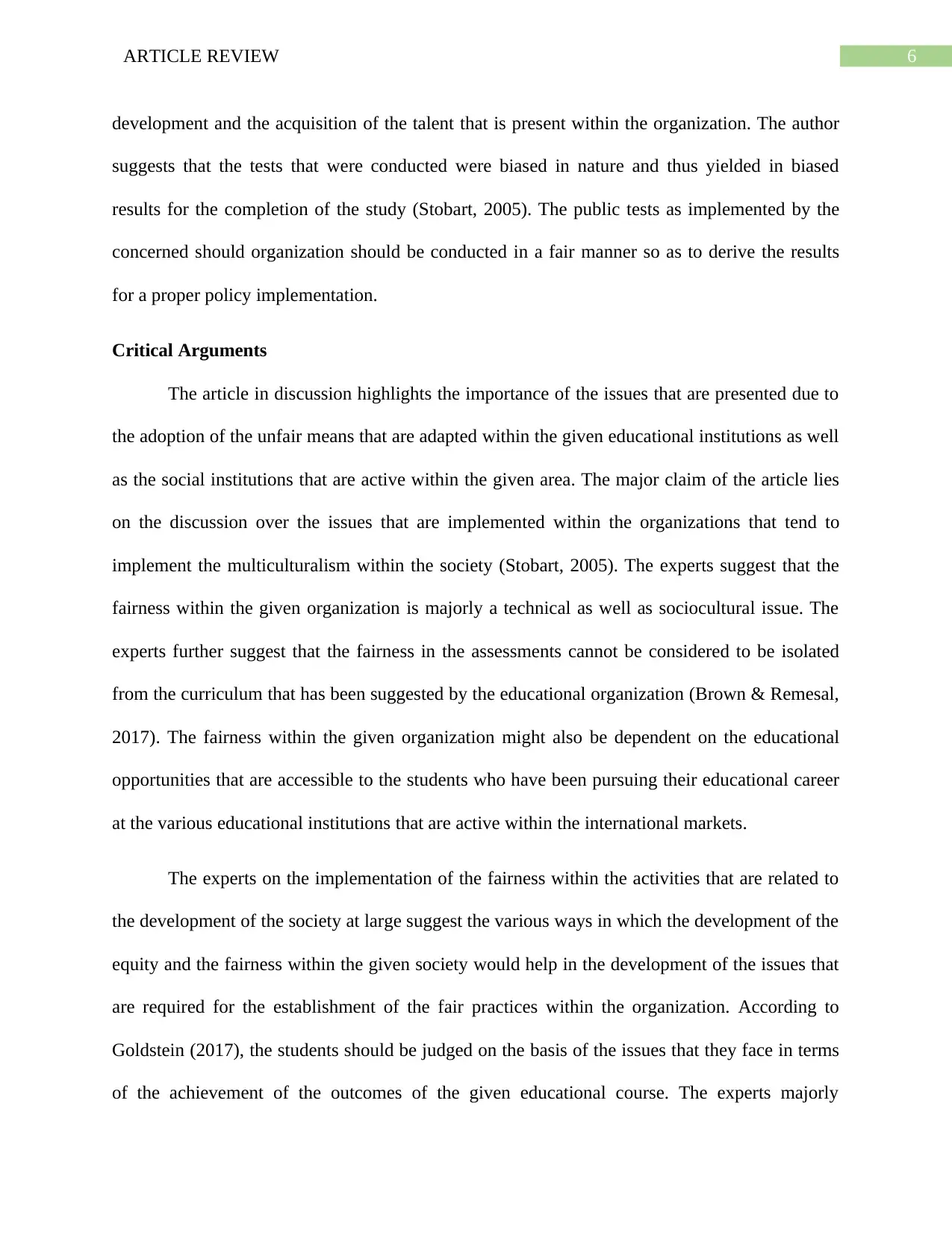
6ARTICLE REVIEW
development and the acquisition of the talent that is present within the organization. The author
suggests that the tests that were conducted were biased in nature and thus yielded in biased
results for the completion of the study (Stobart, 2005). The public tests as implemented by the
concerned should organization should be conducted in a fair manner so as to derive the results
for a proper policy implementation.
Critical Arguments
The article in discussion highlights the importance of the issues that are presented due to
the adoption of the unfair means that are adapted within the given educational institutions as well
as the social institutions that are active within the given area. The major claim of the article lies
on the discussion over the issues that are implemented within the organizations that tend to
implement the multiculturalism within the society (Stobart, 2005). The experts suggest that the
fairness within the given organization is majorly a technical as well as sociocultural issue. The
experts further suggest that the fairness in the assessments cannot be considered to be isolated
from the curriculum that has been suggested by the educational organization (Brown & Remesal,
2017). The fairness within the given organization might also be dependent on the educational
opportunities that are accessible to the students who have been pursuing their educational career
at the various educational institutions that are active within the international markets.
The experts on the implementation of the fairness within the activities that are related to
the development of the society at large suggest the various ways in which the development of the
equity and the fairness within the given society would help in the development of the issues that
are required for the establishment of the fair practices within the organization. According to
Goldstein (2017), the students should be judged on the basis of the issues that they face in terms
of the achievement of the outcomes of the given educational course. The experts majorly
development and the acquisition of the talent that is present within the organization. The author
suggests that the tests that were conducted were biased in nature and thus yielded in biased
results for the completion of the study (Stobart, 2005). The public tests as implemented by the
concerned should organization should be conducted in a fair manner so as to derive the results
for a proper policy implementation.
Critical Arguments
The article in discussion highlights the importance of the issues that are presented due to
the adoption of the unfair means that are adapted within the given educational institutions as well
as the social institutions that are active within the given area. The major claim of the article lies
on the discussion over the issues that are implemented within the organizations that tend to
implement the multiculturalism within the society (Stobart, 2005). The experts suggest that the
fairness within the given organization is majorly a technical as well as sociocultural issue. The
experts further suggest that the fairness in the assessments cannot be considered to be isolated
from the curriculum that has been suggested by the educational organization (Brown & Remesal,
2017). The fairness within the given organization might also be dependent on the educational
opportunities that are accessible to the students who have been pursuing their educational career
at the various educational institutions that are active within the international markets.
The experts on the implementation of the fairness within the activities that are related to
the development of the society at large suggest the various ways in which the development of the
equity and the fairness within the given society would help in the development of the issues that
are required for the establishment of the fair practices within the organization. According to
Goldstein (2017), the students should be judged on the basis of the issues that they face in terms
of the achievement of the outcomes of the given educational course. The experts majorly
Paraphrase This Document
Need a fresh take? Get an instant paraphrase of this document with our AI Paraphraser
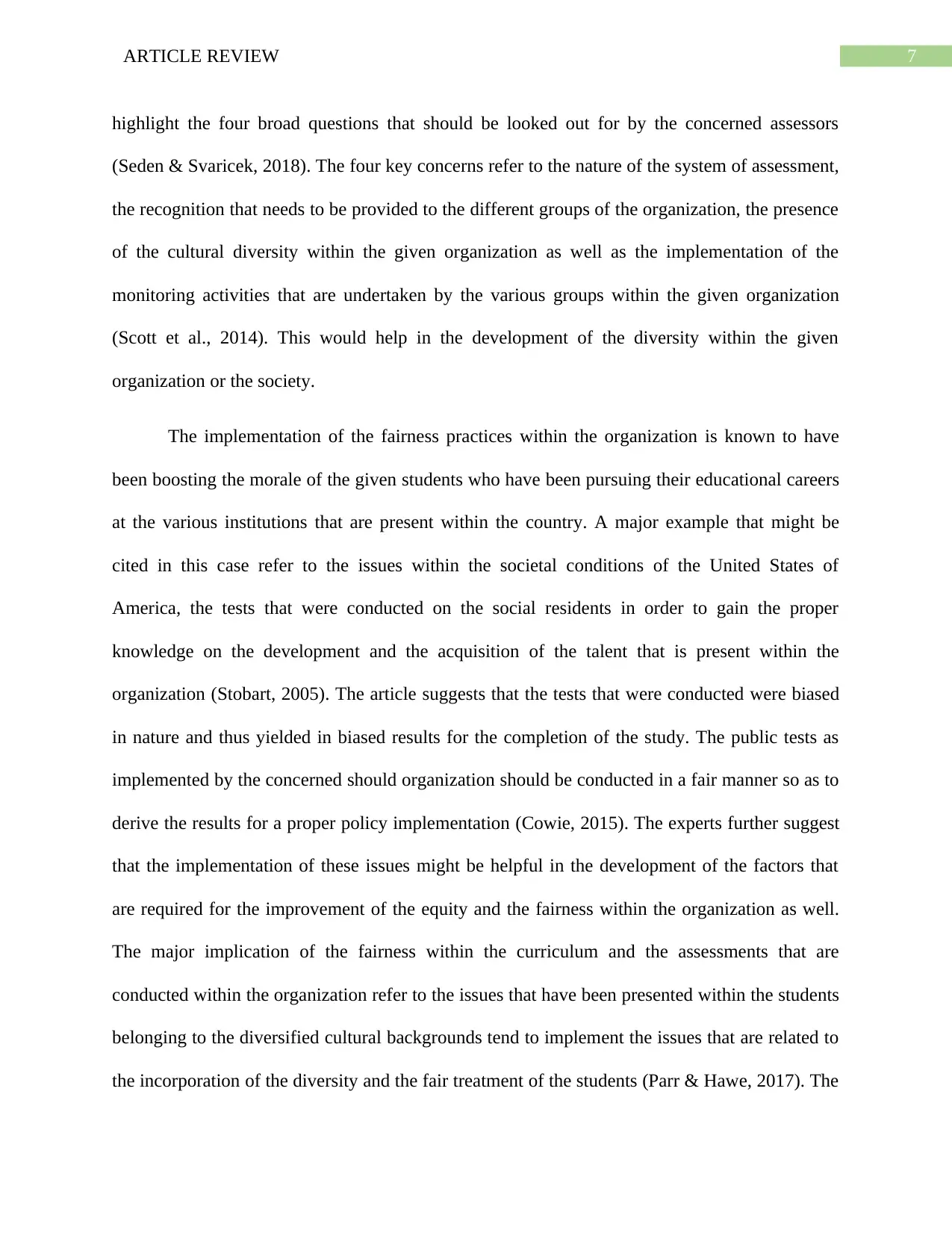
7ARTICLE REVIEW
highlight the four broad questions that should be looked out for by the concerned assessors
(Seden & Svaricek, 2018). The four key concerns refer to the nature of the system of assessment,
the recognition that needs to be provided to the different groups of the organization, the presence
of the cultural diversity within the given organization as well as the implementation of the
monitoring activities that are undertaken by the various groups within the given organization
(Scott et al., 2014). This would help in the development of the diversity within the given
organization or the society.
The implementation of the fairness practices within the organization is known to have
been boosting the morale of the given students who have been pursuing their educational careers
at the various institutions that are present within the country. A major example that might be
cited in this case refer to the issues within the societal conditions of the United States of
America, the tests that were conducted on the social residents in order to gain the proper
knowledge on the development and the acquisition of the talent that is present within the
organization (Stobart, 2005). The article suggests that the tests that were conducted were biased
in nature and thus yielded in biased results for the completion of the study. The public tests as
implemented by the concerned should organization should be conducted in a fair manner so as to
derive the results for a proper policy implementation (Cowie, 2015). The experts further suggest
that the implementation of these issues might be helpful in the development of the factors that
are required for the improvement of the equity and the fairness within the organization as well.
The major implication of the fairness within the curriculum and the assessments that are
conducted within the organization refer to the issues that have been presented within the students
belonging to the diversified cultural backgrounds tend to implement the issues that are related to
the incorporation of the diversity and the fair treatment of the students (Parr & Hawe, 2017). The
highlight the four broad questions that should be looked out for by the concerned assessors
(Seden & Svaricek, 2018). The four key concerns refer to the nature of the system of assessment,
the recognition that needs to be provided to the different groups of the organization, the presence
of the cultural diversity within the given organization as well as the implementation of the
monitoring activities that are undertaken by the various groups within the given organization
(Scott et al., 2014). This would help in the development of the diversity within the given
organization or the society.
The implementation of the fairness practices within the organization is known to have
been boosting the morale of the given students who have been pursuing their educational careers
at the various institutions that are present within the country. A major example that might be
cited in this case refer to the issues within the societal conditions of the United States of
America, the tests that were conducted on the social residents in order to gain the proper
knowledge on the development and the acquisition of the talent that is present within the
organization (Stobart, 2005). The article suggests that the tests that were conducted were biased
in nature and thus yielded in biased results for the completion of the study. The public tests as
implemented by the concerned should organization should be conducted in a fair manner so as to
derive the results for a proper policy implementation (Cowie, 2015). The experts further suggest
that the implementation of these issues might be helpful in the development of the factors that
are required for the improvement of the equity and the fairness within the organization as well.
The major implication of the fairness within the curriculum and the assessments that are
conducted within the organization refer to the issues that have been presented within the students
belonging to the diversified cultural backgrounds tend to implement the issues that are related to
the incorporation of the diversity and the fair treatment of the students (Parr & Hawe, 2017). The
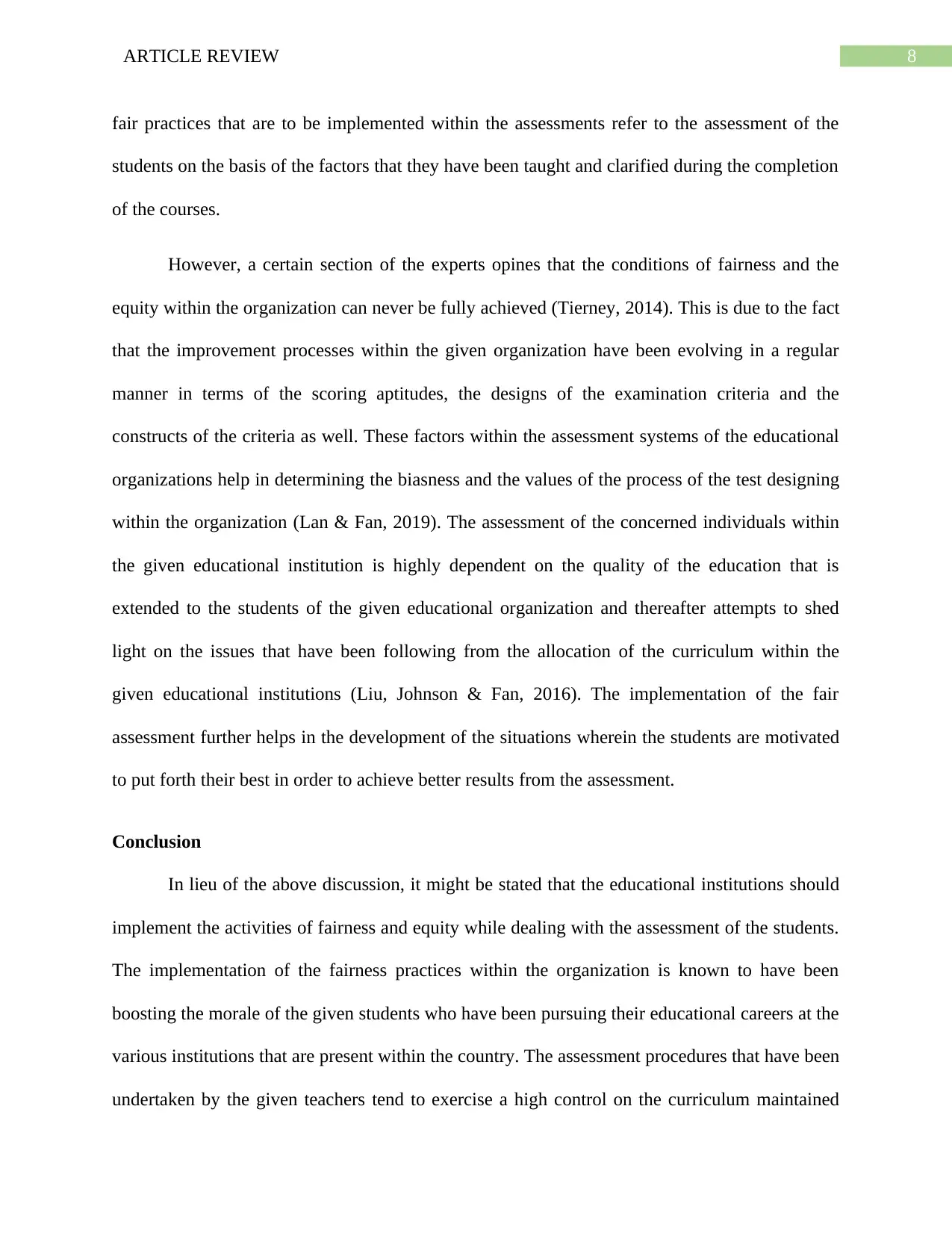
8ARTICLE REVIEW
fair practices that are to be implemented within the assessments refer to the assessment of the
students on the basis of the factors that they have been taught and clarified during the completion
of the courses.
However, a certain section of the experts opines that the conditions of fairness and the
equity within the organization can never be fully achieved (Tierney, 2014). This is due to the fact
that the improvement processes within the given organization have been evolving in a regular
manner in terms of the scoring aptitudes, the designs of the examination criteria and the
constructs of the criteria as well. These factors within the assessment systems of the educational
organizations help in determining the biasness and the values of the process of the test designing
within the organization (Lan & Fan, 2019). The assessment of the concerned individuals within
the given educational institution is highly dependent on the quality of the education that is
extended to the students of the given educational organization and thereafter attempts to shed
light on the issues that have been following from the allocation of the curriculum within the
given educational institutions (Liu, Johnson & Fan, 2016). The implementation of the fair
assessment further helps in the development of the situations wherein the students are motivated
to put forth their best in order to achieve better results from the assessment.
Conclusion
In lieu of the above discussion, it might be stated that the educational institutions should
implement the activities of fairness and equity while dealing with the assessment of the students.
The implementation of the fairness practices within the organization is known to have been
boosting the morale of the given students who have been pursuing their educational careers at the
various institutions that are present within the country. The assessment procedures that have been
undertaken by the given teachers tend to exercise a high control on the curriculum maintained
fair practices that are to be implemented within the assessments refer to the assessment of the
students on the basis of the factors that they have been taught and clarified during the completion
of the courses.
However, a certain section of the experts opines that the conditions of fairness and the
equity within the organization can never be fully achieved (Tierney, 2014). This is due to the fact
that the improvement processes within the given organization have been evolving in a regular
manner in terms of the scoring aptitudes, the designs of the examination criteria and the
constructs of the criteria as well. These factors within the assessment systems of the educational
organizations help in determining the biasness and the values of the process of the test designing
within the organization (Lan & Fan, 2019). The assessment of the concerned individuals within
the given educational institution is highly dependent on the quality of the education that is
extended to the students of the given educational organization and thereafter attempts to shed
light on the issues that have been following from the allocation of the curriculum within the
given educational institutions (Liu, Johnson & Fan, 2016). The implementation of the fair
assessment further helps in the development of the situations wherein the students are motivated
to put forth their best in order to achieve better results from the assessment.
Conclusion
In lieu of the above discussion, it might be stated that the educational institutions should
implement the activities of fairness and equity while dealing with the assessment of the students.
The implementation of the fairness practices within the organization is known to have been
boosting the morale of the given students who have been pursuing their educational careers at the
various institutions that are present within the country. The assessment procedures that have been
undertaken by the given teachers tend to exercise a high control on the curriculum maintained
⊘ This is a preview!⊘
Do you want full access?
Subscribe today to unlock all pages.

Trusted by 1+ million students worldwide
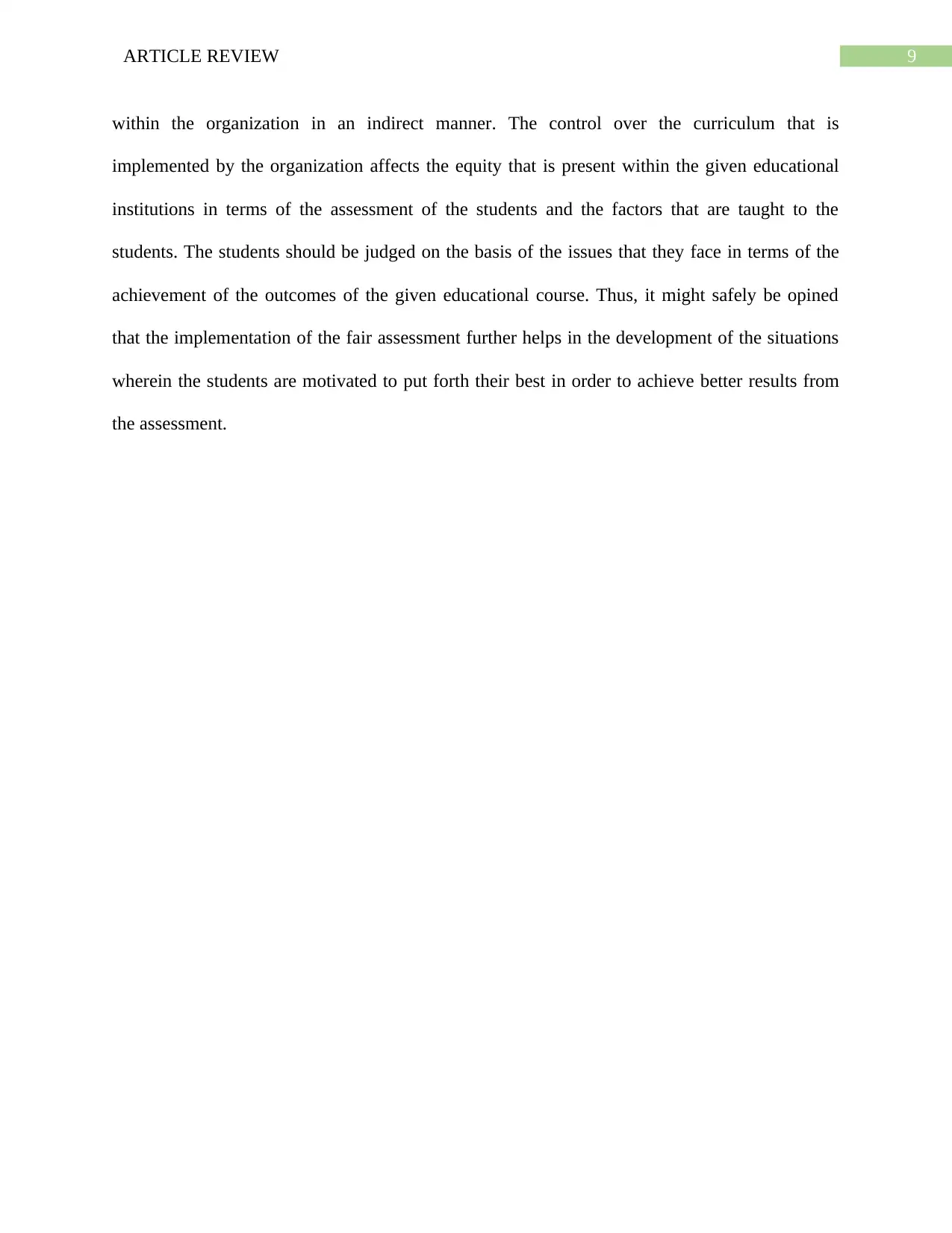
9ARTICLE REVIEW
within the organization in an indirect manner. The control over the curriculum that is
implemented by the organization affects the equity that is present within the given educational
institutions in terms of the assessment of the students and the factors that are taught to the
students. The students should be judged on the basis of the issues that they face in terms of the
achievement of the outcomes of the given educational course. Thus, it might safely be opined
that the implementation of the fair assessment further helps in the development of the situations
wherein the students are motivated to put forth their best in order to achieve better results from
the assessment.
within the organization in an indirect manner. The control over the curriculum that is
implemented by the organization affects the equity that is present within the given educational
institutions in terms of the assessment of the students and the factors that are taught to the
students. The students should be judged on the basis of the issues that they face in terms of the
achievement of the outcomes of the given educational course. Thus, it might safely be opined
that the implementation of the fair assessment further helps in the development of the situations
wherein the students are motivated to put forth their best in order to achieve better results from
the assessment.
Paraphrase This Document
Need a fresh take? Get an instant paraphrase of this document with our AI Paraphraser
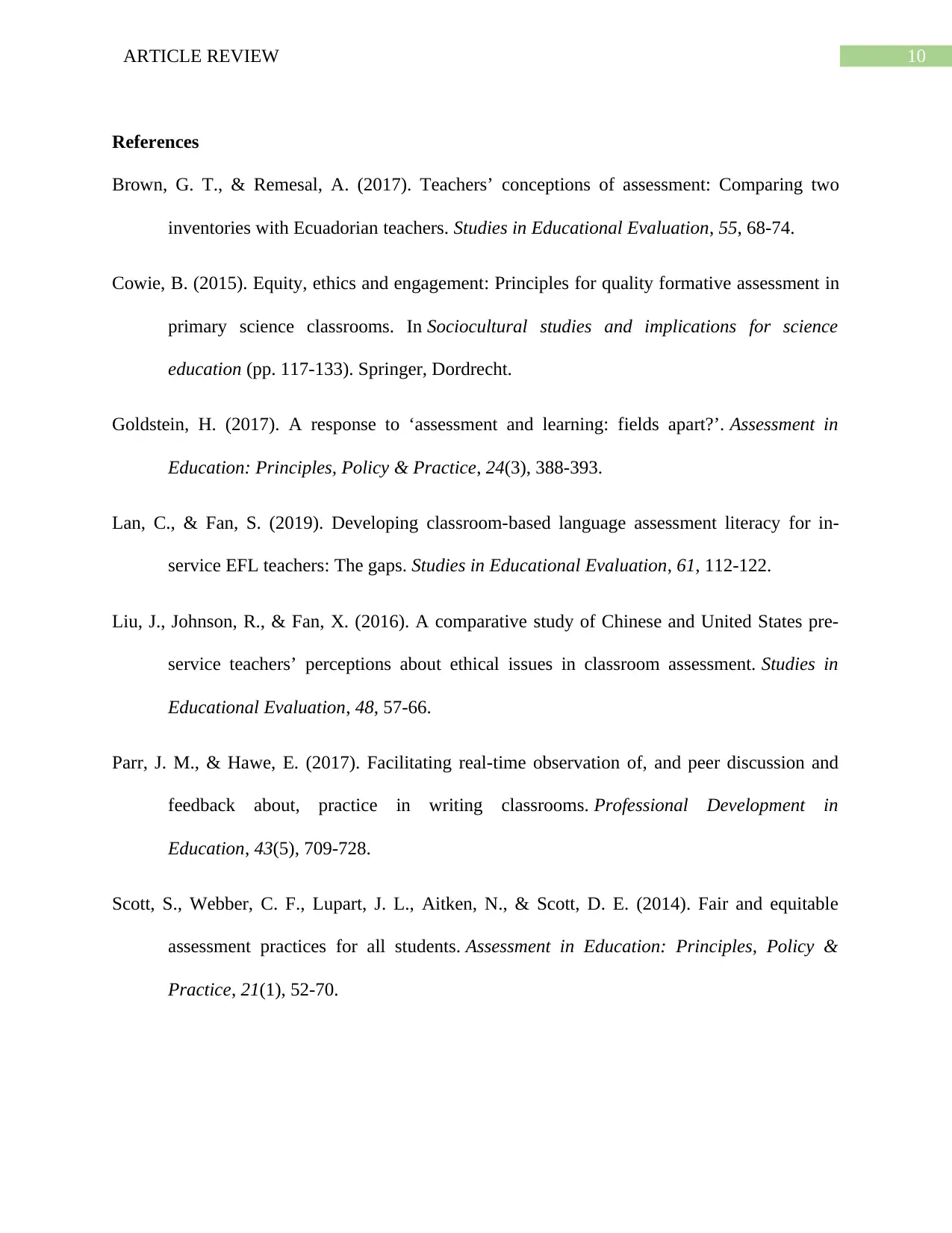
10ARTICLE REVIEW
References
Brown, G. T., & Remesal, A. (2017). Teachers’ conceptions of assessment: Comparing two
inventories with Ecuadorian teachers. Studies in Educational Evaluation, 55, 68-74.
Cowie, B. (2015). Equity, ethics and engagement: Principles for quality formative assessment in
primary science classrooms. In Sociocultural studies and implications for science
education (pp. 117-133). Springer, Dordrecht.
Goldstein, H. (2017). A response to ‘assessment and learning: fields apart?’. Assessment in
Education: Principles, Policy & Practice, 24(3), 388-393.
Lan, C., & Fan, S. (2019). Developing classroom-based language assessment literacy for in-
service EFL teachers: The gaps. Studies in Educational Evaluation, 61, 112-122.
Liu, J., Johnson, R., & Fan, X. (2016). A comparative study of Chinese and United States pre-
service teachers’ perceptions about ethical issues in classroom assessment. Studies in
Educational Evaluation, 48, 57-66.
Parr, J. M., & Hawe, E. (2017). Facilitating real-time observation of, and peer discussion and
feedback about, practice in writing classrooms. Professional Development in
Education, 43(5), 709-728.
Scott, S., Webber, C. F., Lupart, J. L., Aitken, N., & Scott, D. E. (2014). Fair and equitable
assessment practices for all students. Assessment in Education: Principles, Policy &
Practice, 21(1), 52-70.
References
Brown, G. T., & Remesal, A. (2017). Teachers’ conceptions of assessment: Comparing two
inventories with Ecuadorian teachers. Studies in Educational Evaluation, 55, 68-74.
Cowie, B. (2015). Equity, ethics and engagement: Principles for quality formative assessment in
primary science classrooms. In Sociocultural studies and implications for science
education (pp. 117-133). Springer, Dordrecht.
Goldstein, H. (2017). A response to ‘assessment and learning: fields apart?’. Assessment in
Education: Principles, Policy & Practice, 24(3), 388-393.
Lan, C., & Fan, S. (2019). Developing classroom-based language assessment literacy for in-
service EFL teachers: The gaps. Studies in Educational Evaluation, 61, 112-122.
Liu, J., Johnson, R., & Fan, X. (2016). A comparative study of Chinese and United States pre-
service teachers’ perceptions about ethical issues in classroom assessment. Studies in
Educational Evaluation, 48, 57-66.
Parr, J. M., & Hawe, E. (2017). Facilitating real-time observation of, and peer discussion and
feedback about, practice in writing classrooms. Professional Development in
Education, 43(5), 709-728.
Scott, S., Webber, C. F., Lupart, J. L., Aitken, N., & Scott, D. E. (2014). Fair and equitable
assessment practices for all students. Assessment in Education: Principles, Policy &
Practice, 21(1), 52-70.
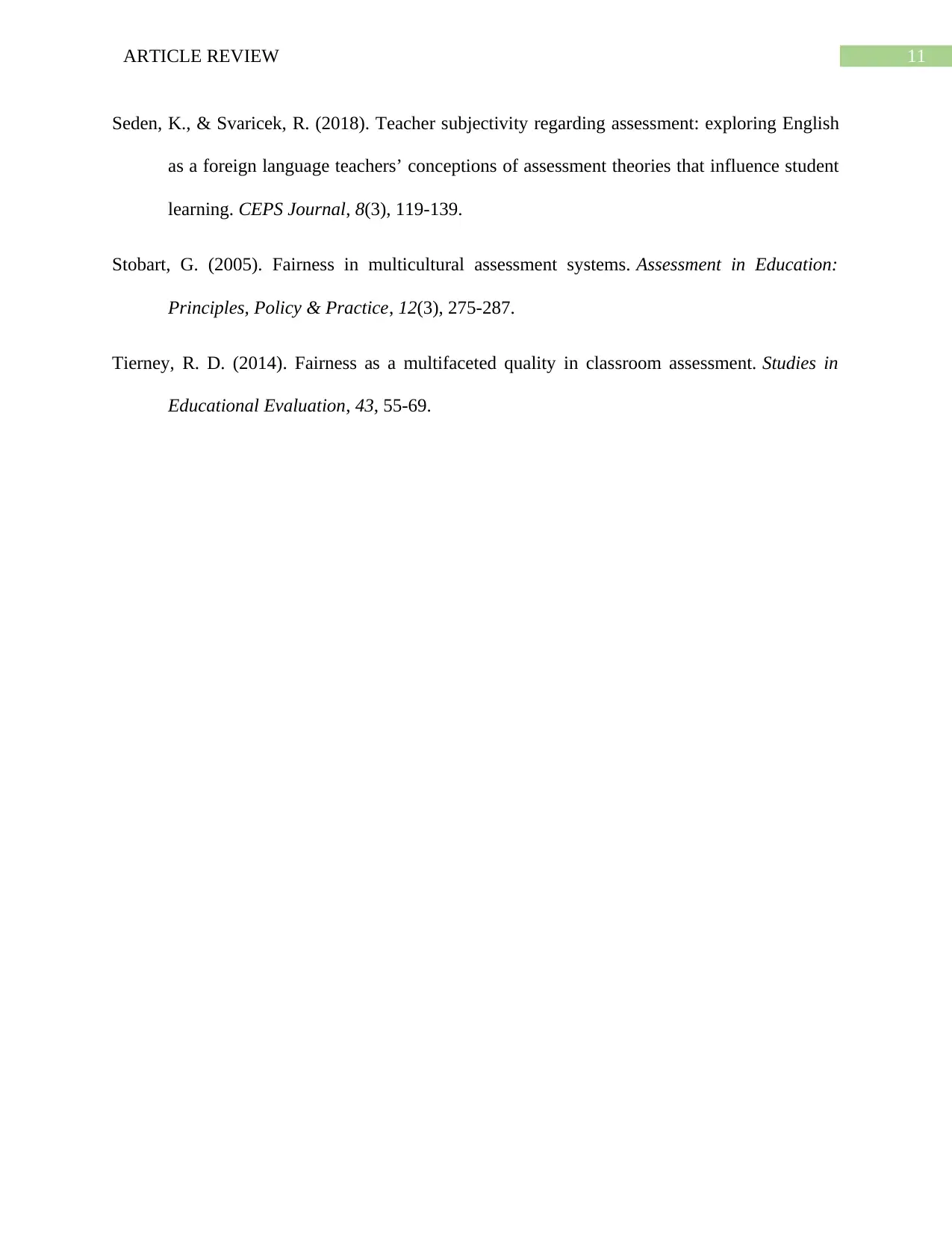
11ARTICLE REVIEW
Seden, K., & Svaricek, R. (2018). Teacher subjectivity regarding assessment: exploring English
as a foreign language teachers’ conceptions of assessment theories that influence student
learning. CEPS Journal, 8(3), 119-139.
Stobart, G. (2005). Fairness in multicultural assessment systems. Assessment in Education:
Principles, Policy & Practice, 12(3), 275-287.
Tierney, R. D. (2014). Fairness as a multifaceted quality in classroom assessment. Studies in
Educational Evaluation, 43, 55-69.
Seden, K., & Svaricek, R. (2018). Teacher subjectivity regarding assessment: exploring English
as a foreign language teachers’ conceptions of assessment theories that influence student
learning. CEPS Journal, 8(3), 119-139.
Stobart, G. (2005). Fairness in multicultural assessment systems. Assessment in Education:
Principles, Policy & Practice, 12(3), 275-287.
Tierney, R. D. (2014). Fairness as a multifaceted quality in classroom assessment. Studies in
Educational Evaluation, 43, 55-69.
⊘ This is a preview!⊘
Do you want full access?
Subscribe today to unlock all pages.

Trusted by 1+ million students worldwide
1 out of 12
Related Documents
Your All-in-One AI-Powered Toolkit for Academic Success.
+13062052269
info@desklib.com
Available 24*7 on WhatsApp / Email
![[object Object]](/_next/static/media/star-bottom.7253800d.svg)
Unlock your academic potential
Copyright © 2020–2025 A2Z Services. All Rights Reserved. Developed and managed by ZUCOL.





